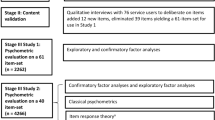Abstract
To investigate the effect of stringent and lenient criteria upon the process of item selection in the development of a health status questionnaire, an item pool (179 items) was administered to 139 patients with left ventricular dysfunction. Associations between each item and the criteria of gender, age, duration of disease, global health and global impairment were examined. Items were selected from the pool on the basis of their associations with the criteria using four levels of stringency. The most stringent criteria rejected items which had a shared variance of ≥4% with gender, age and duration of disease and a shared variance of ≥6% with global health and impairment. The most lenient criteria rejected items which had a shared variance of ≥6% with gender, age and duration of disease and a shared variance of ≥4% with global health and impairment. Using the most stringent criteria, 75 items were selected, compared with 127 items using the most lenient criteria. Small differences in the level of association had large effects on item selection. The choice of level of association used to base item selection can have a crucial influence on questionnaire content.
Similar content being viewed by others
References
Guyatt GH, Bombardier C, Tugwell PX. Measuring disease-specific quality of life in clinical trials. CMAJ 1986; 134: 1986.
Kline P. An Easy Guide to Factor Analysis. London and New York: Routledge, 1994.
Clark LA, Watson D. Constructing validity: basic issues in objective scale development. Psychol Assess 1995; 7(3): 309-319.
Smith GT, McCarthy DM. Methodological considerations in the refinement of clinical assessment instruments. Psychol Assess 1995; 7(3): 300-308.
Mahler DA et al. The measurement of dyspnea. Contents, interobserver agreement, and physiologic correlates of two new clinical indexes. Chest 1984; 85(6): 751-758.
Hunt SM et al. A quantitative approach to perceived health status: a validation study. J Epidemiol Commun Health 1980; 34: 281-286.
Rosenthal M, Lohr KN, Rubenstein RS. Conceptualisation and Measurement of Physiologic Health in Adults. Vol. 5: Congestive Heart Failure. Santa Monica, CA: Rand Corporation, 1981.
Rector TS et al. Evaluation by patients with heart failure of the effects of enalapril compared with hydralazine plus isosorbide dinitrate on quality of life. Circulation 1993; 87(Suppl VI): V171-V177.
Guyatt GH et al. Development and testing of a new measure of health status for clinical trials in heart failure. J Gen Intern Med 1989; 4: 101-107.
Rector TS, Kubo SH, Cohn JN. Patients' self-assessment of their congestive heart failure. Part 2: content, reliability and validity of a new measure, the Minnesota Living with Heart Failure Questionnaire. Heart Failure 1987; 3: 198-209.
Jones PW, Quirk FH, Baveystock CM. The St Georges Respiratory Questionnaire. Respirat Med 1991; 85(Suppl B): 25-31.
Bergner M et al. The Sickness Impact Profile: development and final revision of a health status measure. Med Care 1981; XIX: 787-805.
Wiklung I et al. Self-assessment of quality of life in severe heart failure. Scand J Psychol 1987; 28: 220-225.
Goldman L et al. Pitfalls in the serial assessment of cardiac functional status. How a reduction in “ordinary” activity may reduce the apparent degree of cardiac compromise and give a misleading impression of improvement. J Chronic Dis 1982; 35: 763-771.
Working Group on Rehabilitation of the European Society of Cardiology. Risk of poor quality of life. Eur Heart J 1992; 13:(Suppl C): 20-34.
Feinstein AR, Fisher MB, Pigeon JG. Changes in dyspnea-fatigue ratings as indicators of quality of life in the treatment of congestive heart failure. Am J Cardiol 1989; 64: 50-55.
Godden J. Educating patients about congestive cardiac failure. Nursing Times 1994; 90(28): 29-30.
Goodyer LI. Measurement of the effects of medication counselling given to elderly patients with heart failure. King's College London: PhD thesis, 1992.
Grady KL. Quality of life in patients with chronic heart failure. Crit Care Nursing Clinics N Am 1993; 5(4): 661-670.
Jackson G. Heart Failure, 2nd edn. London: Martin Dunitz Ltd, 1993.
Jenkins CD et al. The measurement of health related quality of life: major dimensions identified by factor analysis. Soc Sci Med 1990; 31(8): 925-931.
Kannel WB. Epidemiology and prevention of cardiac failure: Framingham Study insights. Eur Heart J 1987; 8(Suppl F): 23-39.
Mayou R et al. Cardiac failure: symptoms and functional status. J Psychosomat Res 1991; 35(4/5): 399-407.
McFate Smith W. Epidemiology of congestive heart failure. Am J Cardiol 1985; 55: 3A-8A.
McKee PA et al. The natural history of congestive heart failure: the Framingham Study. N Engl J Med 1971; 285(26): 1441-1446.
Milne BJ, Logan AG, Flanagan PT. Alterations in health perceptions and lifestyle in treated hypertensives. J Chronic Dis 1985; 38(1): 37-45.
O'Boyle CA. Quality of life and cardiovascular medication. Irish J Psychol 1994; 15(1): 126-147.
Pouleur H. Improving patient care: some unresolved issues in heart failure. Cardiology 1994; 84(6): 408-412.
Tandon PK, Stander H, Schwarz P, Jr. Analysis of quality of life data from a randomized, placebo-controlled heart failure trial. J Clin Epidemiol 1989; 42(10): 955-962.
Wenger NK. Quality of life in chronic cardiovascular illness. Ann Acad Med Singapore 1992; 21(1): 137-140.
Howell DC. Statistical Methods for Psychology, 2nd edn. Boston: PWS Publishers, 1987.
Author information
Authors and Affiliations
Rights and permissions
About this article
Cite this article
O'Leary, C.J., Jones, P.W. The influence of decisions made by developers on health status questionnaire content. Qual Life Res 7, 545–550 (1998). https://doi.org/10.1023/A:1008882626075
Issue Date:
DOI: https://doi.org/10.1023/A:1008882626075




